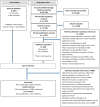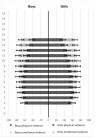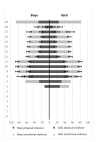Who perpetrates violence against children? A systematic analysis of age-specific and sex-specific data
- PMID: 29637183
- PMCID: PMC5842994
- DOI: 10.1136/bmjpo-2017-000180
Who perpetrates violence against children? A systematic analysis of age-specific and sex-specific data
Abstract
Objective: The epidemiology of violence against children is likely to differ substantially by sex and age of the victim and the perpetrator. Thus far, investment in effective prevention strategies has been hindered by lack of clarity in the burden of childhood violence across these dimensions. We produced the first age-specific and sex-specific prevalence estimates by perpetrator type for physical, sexual and emotional violence against children globally.
Design: We used random effects meta-regression to estimate prevalence. Estimates were adjusted for relevant quality covariates, variation in definitions of violence and weighted by region-specific, age-specific and sex-specific population data to ensure estimates reflect country population structures.
Data sources: Secondary data from 600 population or school-based representative datasets and 43 publications obtained via systematic literature review, representing 13 830 estimates from 171 countries.
Eligibility criteria for selecting studies: Estimates for recent violence against children aged 0-19 were included.
Results: The most common perpetrators of physical and emotional violence for both boys and girls across a range of ages are household members, with prevalence often surpassing 50%, followed by student peers. Children reported experiencing more emotional than physical violence from both household members and students. The most common perpetrators of sexual violence against girls aged 15-19 years are intimate partners; however, few data on other perpetrators of sexual violence against children are systematically collected internationally. Few age-specific and sex-specific data are available on violence perpetration by schoolteachers; however, existing data indicate high prevalence of physical violence from teachers towards students. Data from other authority figures, strangers, siblings and other adults are limited, as are data on neglect of children.
Conclusions: Without further investment in data generation on violence exposure from multiple perpetrators for boys and girls of all ages, progress towards Sustainable Development Goals 4, 5 and 16 may be slow. Despite data gaps, evidence shows violence from household members, peers in school and for girls, from intimate partners, should be prioritised for prevention.
Trial registration number: PROSPERO 2015: CRD42015024315.
Keywords: bullying; child abuse; intimate partner violence; school violence; violence against children.
Conflict of interest statement
Competing interests: None declared.
Figures






References
-
- Hillis S, Mercy J, Amobi A, et al. . Global prevalence of past-year violence against children: a systematic review and minimum estimates. Pediatrics 2016;137:e20154079 doi:10.1542/peds.2015-4079 - DOI - PMC - PubMed
-
- Pereda N, Guilera G, Forns M, et al. . The international epidemiology of child sexual abuse: a continuation of Finkelhor (1994). Child Abuse Negl 2009;33:331–42. doi:10.1016/j.chiabu.2008.07.007 - DOI - PubMed
-
- Stoltenborgh M, van Ijzendoorn MH, Euser EM, et al. . A global perspective on child sexual abuse: meta-analysis of prevalence around the world. Child Maltreat 2011;16:79–101. doi:10.1177/1077559511403920 - DOI - PubMed
-
- De Bellis MD, Hooper SR, Sapia JL. Early trauma exposure and the brain., 2005.
-
- Andersen SL, Tomada A, Vincow ES, et al. . Preliminary evidence for sensitive periods in the effect of childhood sexual abuse on regional brain development. J Neuropsychiatry Clin Neurosci 2008;20:292–301. doi:10.1176/jnp.2008.20.3.292 - DOI - PMC - PubMed
Grants and funding
LinkOut - more resources
Full Text Sources
Other Literature Sources
